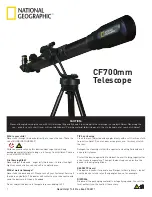
35
Looking at or near the
Sun
will cause
irreversible
damage to your eye. Do not point this telescope at or near the
Sun. Do not look through the telescope as it is moving.
Object Menu
Almost all observing with Autostar II is performed using the Object menu category.
(
Note:
Exceptions include Guided Tour and Landmark Survey.
)
Autostar II contains many libraries of viewable objects, such as stars, planets, comets,
nebulae and so forth. When one of these objects is selected from a library, Autostar II
moves your telescope (if properly aligned) and points it at the selected object. Six of the
most popular libraries can be accessed directly using the hot buttons.
The Object Menu options include:
Solar System:
A library of the eight planets (Earth is not included) in order out from
the Sun, followed by the Moon, asteroids, and comets (Number key "5").
Constellation:
A library of all 88 Northern and Southern Hemisphere constellations.
When this menu option is chosen and a constellation name appears on the first line
of the screen, press GO TO and the telescope goes to the center of the constellation
and will display coordinates. Then, use the Scroll keys to cycle through the list of the
most significant stars in the constellation. Then it will display deep space objects and
so forth in the constellation.
Deep Sky
: A library of objects outside our Solar System such as nebulae, star clus-
ters, galaxies, and quasars.
Star:
A catalog of stars listed in different categories such as named, double, variable,
or nearby. Also included are the Hipparcos, SAO, HD, and HR catalogs. The Star cat-
alog may also be accessed directly by pressing Number key "6."
Satellite:
A library of Earth-orbiting objects such as the International Space Station,
the Hubble Space Telescope, Global Positioning System (GPS) satellites, and geo-
synchronous orbit satellites.
Other
Catalogs
are accessed directly using the Autostar II "hot keys": Caldwell (key
"2"), Messier catalog ("3"), Solar System ("5"), IC ("8"), and NGC ("9").
To slew the telescope to catalog objects:
Enter the catalog number of the object using the Number keys and then press ENTER.
For example: To slew to NGC 6720, press Number Key "9," then using the Number
keys, enter the digits "6-7-2-0." Then press ENTER.
Autostar II displays the common name and alternate names of the object, if available.
Press one of the Scroll keys to display some or all of the following information about
that object: Type of object (galaxy, nebula, etc.), Dec. and R.A. coordinates, constella-
tion it is located within, magnitude, size, distance, and star-type classification, if the
object is a star. If further information is available, it displays as scrolling text.
Press GO TO. The telescope, if aligned, will slew to that chosen object. Press MODE
repeatedly to return to previous menu levels.
User Objects:
Allows the user to define and store in memory deep-sky objects of spe-
cific interest that are not currently in the Autostar II libraries. See
CREATING USER
OBJECTS
, page 42, for more information.
Identify:
An exciting feature for an observer who wants to scan the night sky and start
exploring. After the telescope has been properly aligned, use the Autostar II Arrow
keys to move about in the sky. Then follow this procedure:
Important Note:
Only use the Arrow keys to move the telescope during
the Identify procedure. Do not loosen the telescope locks or move the
base or alignment is lost.
1.
When a desired object is visible in the eyepiece, keep pressing MODE until the
“Select Item: Object” menu is displayed. Press ENTER to select this menu.
2.
Scroll through the Object menu options until the “Object: Identify” screen appears.
3.
Press ENTER. Autostar II searches the libraries for the identity of the object being
observed.
4.
If the telescope is not directly on an Autostar II library object, the nearest library
object is located and displayed on the screen. Press GO TO and the telescope
slews to that object.
Summary of Contents for MAX-ACF
Page 59: ......






































